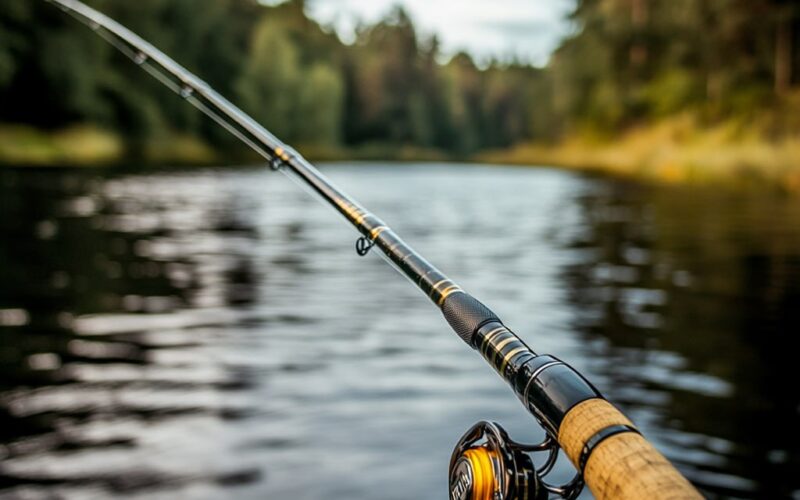Types of Fishing Rods
Fishing rods come in various types, each designed for specific fishing techniques. The most common types are spinning rods, casting rods, and fly rods. Spinning rods are the most versatile and user-friendly, making them ideal for beginners. Casting rods, on the other hand, provide greater accuracy and control, making them a favorite for more experienced anglers. Fly rods are specialized for fly fishing, offering the necessary flexibility to cast lightweight flies.
When choosing a fishing rod, it’s important to consider the type of fishing you will be doing. If you’re planning to fish in freshwater, a spinning rod may be your best option. For saltwater or heavier fishing, a casting rod with greater strength and durability is recommended. Fly rods are perfect for anglers who are focused on the art of fly fishing, with their unique design suited to casting light lures over long distances.
Material and Build Quality
The material and build quality of a fishing rod are crucial factors that influence both durability and performance. Modern fishing rods are typically made from materials like graphite, fiberglass, and composite blends. Graphite rods are lightweight and sensitive, offering great precision in casting, while fiberglass rods are more durable and flexible, making them ideal for rough conditions. Composite rods, which blend both materials, aim to provide the best of both worlds.
When selecting a fishing rod, consider the conditions in which you will be fishing. If you’re fishing in rugged, rocky environments, a fiberglass rod might be your best choice due to its toughness. For finesse fishing, where sensitivity is key, a graphite rod would offer superior performance. The build quality, including the reel seat and guides, should also be checked, as poorly constructed rods can lead to breakage and reduced performance.
Rod Length and Power
The length and power of a fishing rod are essential factors that determine how it handles different types of fish and fishing styles. Longer rods, typically between 7 and 10 feet, are ideal for casting long distances and handling larger fish. Shorter rods, usually between 5 and 6 feet, are better suited for close-quarter fishing and offer greater control. The rod’s power refers to its lifting strength, with light power rods ideal for small fish and heavy power rods designed for larger, more aggressive species.
Choosing the right rod length and power depends on your fishing environment and target species. For example, if you’re fishing in a small creek, a short rod with light power will give you better maneuverability and control. On the other hand, if you’re fishing in open water for big fish like pike or bass, a long rod with heavy power will allow you to cast farther and handle the force of the catch more effectively.
Rod Action and Sensitivity
Rod action refers to how much the rod bends when pressure is applied, and sensitivity measures the ability of the rod to detect bites and movement. Fast-action rods bend near the tip, providing excellent sensitivity and quick response, making them ideal for precise fishing techniques. Slow-action rods bend more throughout their length, offering more forgiveness and making them suitable for beginners or anglers fishing for smaller fish. The faster the action, the better the sensitivity and responsiveness of the rod.
Sensitivity is crucial for detecting bites, especially when fishing with lighter lures or in challenging conditions. A sensitive rod can help you detect even the slightest nibble, which is vital for successful hook-setting. However, some anglers prefer a rod with less sensitivity to help with longer fishing sessions, as it provides more cushioning for the arms and hands.
Reel Compatibility
When purchasing a fishing rod, it’s essential to consider reel compatibility. The reel must match the rod’s design, ensuring that both components work together efficiently. Spinning rods require spinning reels, which sit below the rod, while casting rods are paired with baitcasting reels, which sit on top. Fly rods are paired with fly reels, which are designed for the specific demands of fly fishing.
To ensure compatibility, always check the rod’s specifications regarding reel size and weight. A mismatched reel can affect the casting distance and accuracy. Additionally, the type of reel you choose can influence how easily you retrieve the line and the drag system, which controls the tension on the line during a fight with a fish.
Price vs. Performance
When purchasing a fishing rod, finding the right balance between price and performance is essential. Fishing rods are available in a broad price range, from budget-friendly models to high-end premium rods, each offering different features and performance levels. While expensive rods tend to have better materials, lighter construction, and superior sensitivity, they might not always be necessary for casual or beginner anglers. On the other hand, mid-range rods can often provide adequate performance without the high price tag, offering a solid balance of quality and cost.
For beginners or recreational anglers, a well-constructed, moderately priced rod is often sufficient. These rods may not have the latest materials or cutting-edge technology, but they offer reliable performance for a variety of fishing situations. Experienced anglers, especially those who fish frequently or target larger species, may benefit from investing in higher-end rods. These rods are typically built with advanced materials like carbon fiber or high-modulus graphite, which offer exceptional sensitivity, strength, and weight reduction. However, it’s important to remember that spending a lot of money on a rod doesn’t guarantee fishing success. Your skill and technique as an angler are just as crucial, so it’s important to choose a rod that fits your fishing needs and budget.
- Consider your budget when purchasing a fishing rod.
- More expensive rods often offer better sensitivity, lighter weight, and superior durability.
- Mid-range rods can provide adequate performance for casual or beginner anglers.
- High-end rods are ideal for experienced anglers who fish frequently or target larger species.
- Always remember that a rod’s performance and your skill level are equally important.
Selecting the right fishing rod involves finding a balance between price and performance. The best rod for you depends on your fishing style, frequency, and target species. While higher-end rods offer premium features, a good mid-range rod can be more than enough for most anglers. Regardless of the price, ensuring that the rod suits your needs is the key to a successful and enjoyable fishing experience.
Questions and answers
Answer 1: The most common types are spinning rods, casting rods, and fly rods.
Answer 2: Graphite rods are lightweight and sensitive, while fiberglass rods are durable and flexible.
Answer 3: Rod length and power determine how the rod handles different fish and fishing styles, with longer rods ideal for casting farther and heavier rods suitable for larger fish.
Answer 4: Rod action determines how much the rod bends, with fast-action rods offering better sensitivity and response, while slow-action rods provide more forgiveness.
Answer 5: Reel compatibility ensures that the rod and reel work together efficiently, affecting casting distance and ease of line retrieval.

